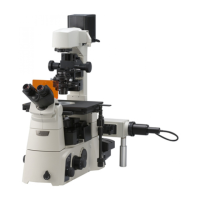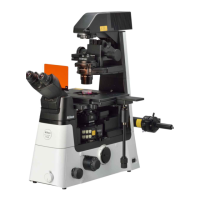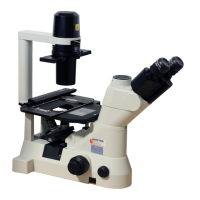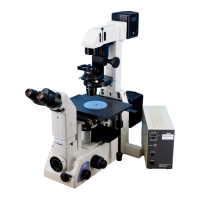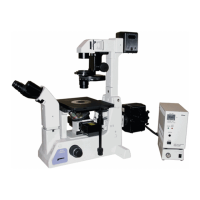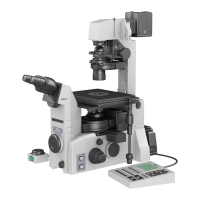Chapter 2 Microscopy
2.4 External Phase Contrast Microscopy
43
2.4 External Phase Contrast Microscopy
External phase contrast microscopy is a microscopy method proposed by Nikon to be a new standard
function of inverted research microscopes.
Traditionally, phase contrast microscopy required the use of special objectives with a built-in phase ring (See
Figure 2-2). The phase ring is coated with a phase film, as well as an ND film (light reduction film) for
reducing the amount of zero-order light (direct light) that passes. These films sometimes affect imaging and
laser transmission, making the phase contrast objectives difficult to use for other applications (i.e. optical
tweezers and total reflection fluorescence microscopy).
Figure 2-2 Optical path for traditional phase contrast microscopy
An external phase contrast system takes an image on the primary image plane, and refocuses it on the
secondary image plane via relay optics. The adoption of such an optical system allows the phase ring to be
placed midway in the relay optics, instead of in the objective. In other words, the phase ring can be moved
out of the objective (See Figure 2-3). As a result, phase contrast microscopy can now be performed with
normal objectives (without a phase ring), and phase contrast objectives are no longer required.
Figure 2-3 Optical path for external phase contrast microscopy
A camera port is also provided on the external phase contrast optics system, enabling photomicroscopy of
phase contrast images. For example, a primary image plane camera port (i.e. side port of an inverted
microscope) can be use to capture bright fluorescent images unaffected by the phase ring, while by
switching the optical path, the camera port on the external phase contrast eyepiece base unit can be used to
capture phase contrast images.
The external phase contrast system also supports high-NA TIRF (total internal reflection fluorescence)
objectives such as Apo TIRF 60x H/1.49 and Apo TIRF 100x H/1.49, allowing TIRF objectives to be fully
utilized for applications that require bright fluorescence images (i.e. monomolecular fluorescence
microscopy), while also allowing morphological observations to be performed without changing the objective.
Annular diaphragm
Condenser
Specimen
Objective
Secondary
objective
Primary image plane
Phase ring
Secondary
image plane
Secondary image
plane (camera port)
epi-fl, TIRF illumination,
o
tical tweezers
etc.
Relay optics
Annular diaphragm
Condenser
Specimen
Objective
Secondary
objective
Phase ring
Epi-fl, TIRF illumination,
o
tical tweezers, etc.
Image plane
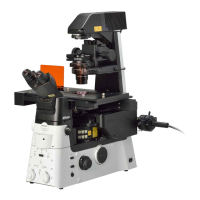
